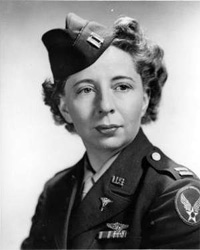Ellen Church: The first air hostess.
 In 1930, Ellen was ideally qualified to become the first air hostess. She was a registered pilot and a qualified nurse. In those days, airlines wouldn’t employ female pilots (for reasons known only to them) but Ellen persuaded them that cabin crew should be trained in nursing.
In 1930, Ellen was ideally qualified to become the first air hostess. She was a registered pilot and a qualified nurse. In those days, airlines wouldn’t employ female pilots (for reasons known only to them) but Ellen persuaded them that cabin crew should be trained in nursing.
Flying was a rather hazardous business in those days — you only have to think of the large number of celebrities who lost their lives in air crashes — but nevertheless it was exciting and was opening up the world for more people, not just the wealthy.
But understandably, people were nervous about this relatively new-fangled mode of transport. It was new technology and people simply didn’t understand how planes stayed up in the air. (And I have to admit that despite it being explained to me often, I still don’t understand it).
Ellen believed that a nurse’s training would help to sooth nervous passengers and thus became the world’s first air hostess. She was also responsible for the recruitment and training of other nurses to fulfil the same role.
Air hostess requirements
To work as female cabin crew in those days, an applicant had to be unmarried. Divorced or widowed women would be ‘considered’ providing they had no children. They also had to be under twenty five years of age. It was necessary to be under 5′ 4″ in height – presumably because of the low headroom in the planes of the day – and their was also a weight requirement; applicants had to weigh under 115 pounds.
Although the airlines claimed that the height and weight restrictions were due to the cramped conditions in the aircraft, they soon realised that passengers – often males travelling on business – appreciated the ministrations of attractive young women. Other airlines soon followed suit.
All these restrictions were eventually outlawed by equality legislation, although airlines still prefer cabin crew who are of a normal weight for their height.
Originally, Ellen and her fellow stewardesses wore their normal nursing uniform. Although this was reassuring for some passengers, especially those who suffered from motion sickness, Ellen realised that for some people the uniform had a negative subconscious effect and she designed the first air hostess uniform.
World War II
Ellen’s first flight as an air hostess was on May 15th, 1930. Until then, only men had been used to care for and serve passengers. Although she was the first air hostess, her career for the airline lasted for less than two years as she was injured in an automobile accident. Ten years after Ellen had first flown as cabin crew, the United States joined the Second World War.
This put an end to the practice of employing nurses to act as flight attendants as they were needed urgently to work in hospitals – both military and civilian. Ellen however joined the Army Nurse Corps and earned various medals for her work.
Finale
For almost two years Ellen had travelled by air as her regular job. In the war, her role wasan extremely dangerous one. She survived — only to succumb to the injuries she received in a horse riding accident at the age of sixty.
ABOUT THE AUTHOR


